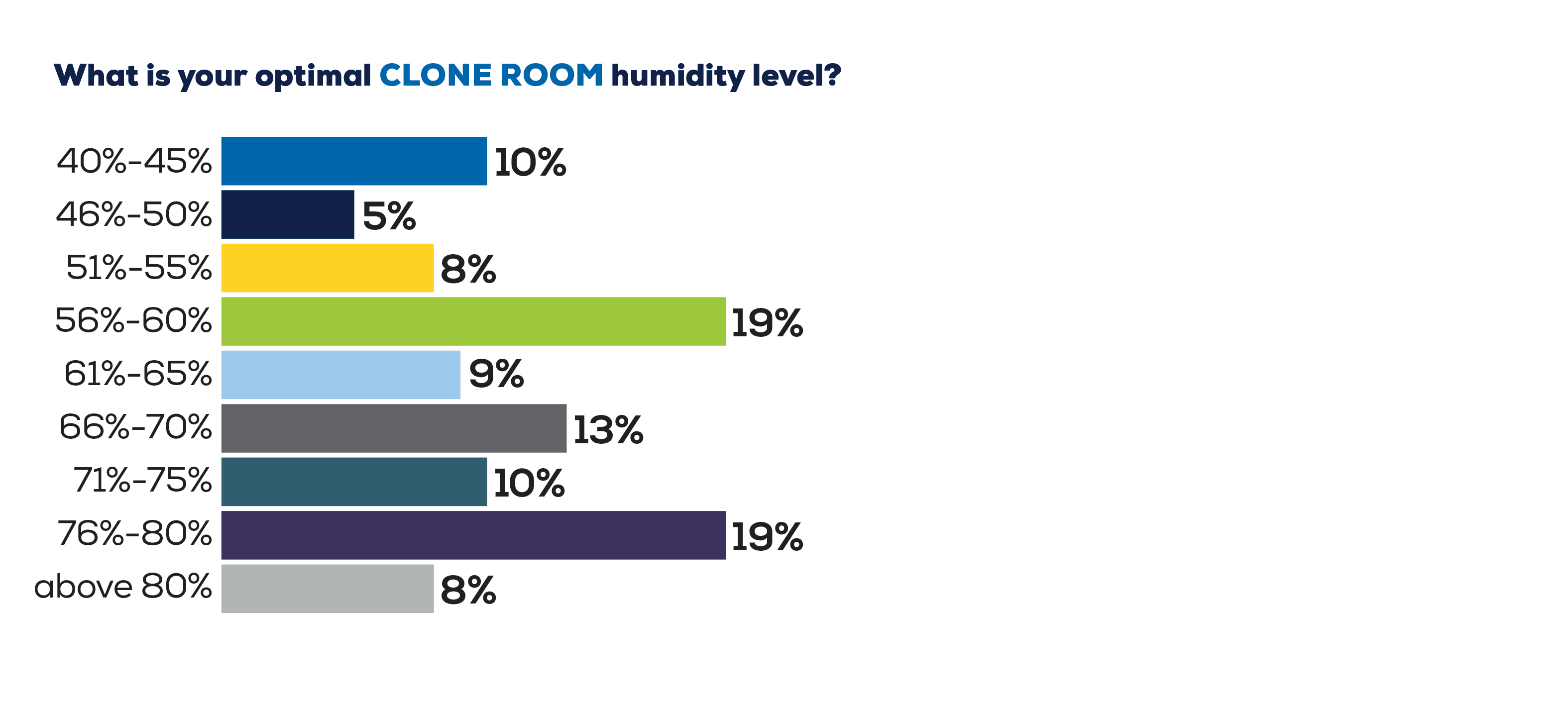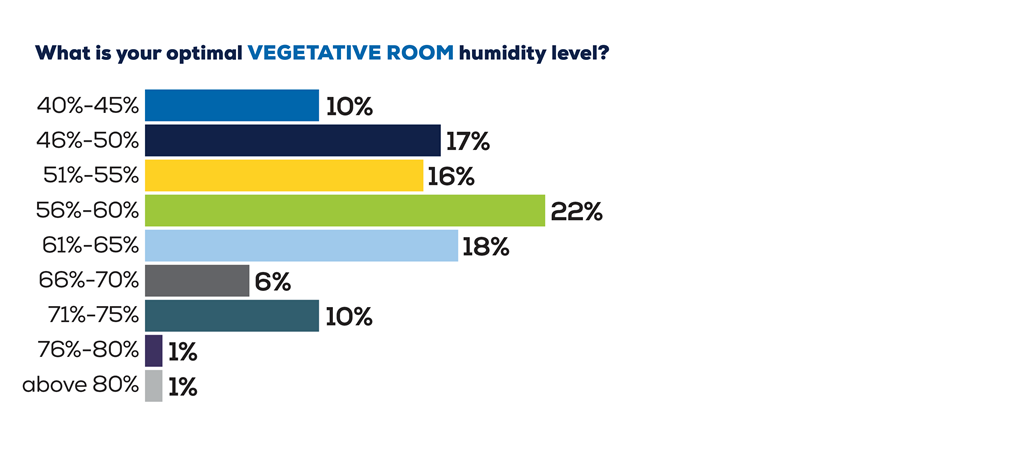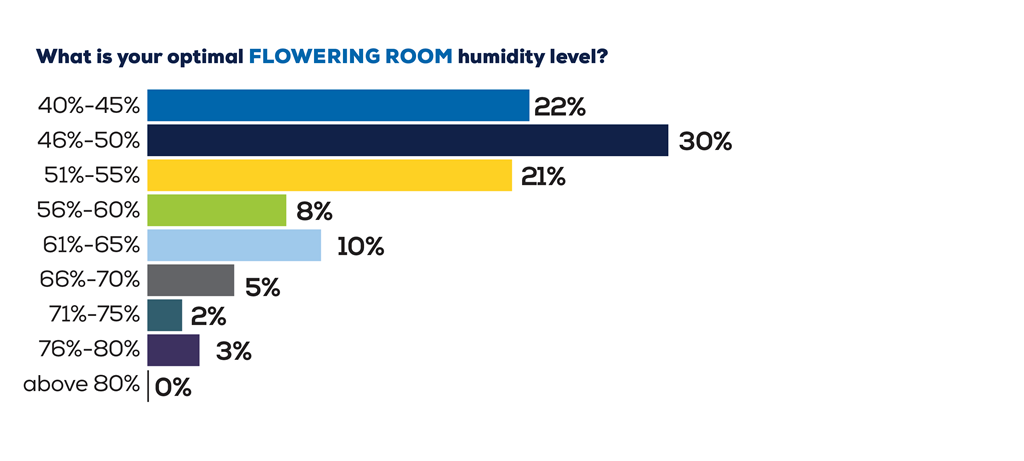Welcome to ‘Smart Humidity’

Humidity. It’s one of the most critical elements in cannabis cultivation. But how many growers truly understand best practices when it comes to controlling humidity and what levels are ideal not only for minimizing disease, but also for maximizing plant health and yield? What are the benchmarks that can help guide you in your own facility, especially if you’re facing challenges with regulating humidity?
Cannabis Business Times (CBT) set out to find some answers. Our first-ever “Smart Humidity Special Report,” made possible by support from Quest Dehumidifiers, is packed with data from proprietary research, and insights from cultivators and experts on just these topics. The report will give you an idea where your humidity-control practices fall among your peers, tips for controlling humidity, why it’s so important to apply smart strategies and more.
Note: Totals may be slightly lower than or exceed 100% due to rounding.
Humidity control can be the bane of some cultivators’ existence. Rapid temperature drops into night cause humidity to jump upward, often into the danger zone. Daytime heat, or heat from lighting, causes humidity to drop; thirsty plants can wilt under that stress. But temperature is just one consideration toward controlling humidity; there are other factors that come into play, too. We will dive more deeply into many of these factors on the following pages.
When humidity levels aren’t just right, cannabis crops and your employees suffer. Many growers know that low humidity and dry conditions can create an appealing environment for spider mites, and high humidity can create an environment ripe for Botrytis, among other diseases.
What some may not know, however, is that in addition to the obvious risks to crops, you and your staff could also face health risks. “The combination of warm temperatures and high humidity found in many indoor marijuana grow operations can fuel extensive mold growth,” stated Dr. Martyny in a press release from National Jewish Health, regarding a study of the potential hazards of cannabis cultivation. “Airborne levels of mold spores that we found inside these structures may subject the occupants … to significant health hazards, especially allergies, asthma, hypersensitivity pneumonitis and other respiratory diseases.”
With these risks, it’s not surprising that more than three-fourths of cultivators who participated in CBT’s research said that humidity control is either very concerning (48%) or concerning (30%). And just 3% of participants said it is not a concern.

Growth Stages and Humidity Control
While most growers agree that humidity is a concern, they are not in agreement on the optimal humidity levels at various growth stages of the cannabis plant. And while many growers admit to being unsure of their humidity-control practices, others say that their optimal room humidity levels absolutely work for them.
For clone rooms, 19 percent of research participants said the ideal humidity level is 56%-60%. The same number of respondents said that, ideally, the humidity level should fall in the range of 76% to 80%. In all, the research showed that desired humidity levels in clone rooms varies from 40%-45% to above 80%.

For veg rooms, study participants’ responses varied almost as much, with the same number of respondents (10%) saying the ideal humidity level in these rooms is 40%-45% as those who said 71%-75%. The largest number of respondents (22%)—well shy of any kind of majority—indicated that their ideal humidity level in veg rooms is 56%-60%, followed by 18% who said ideal humidity in these rooms is 61%-65%.

In the flowering stage, growers came closer to a consensus. Nearly three-fourths (73%) of respondents said the optimal humidity level in flowering rooms is in the range of 40% to 55%. Eighteen percent said 56% to 65%. While 3% of cultivators said that their ideal flower-room humidity level is in the range of 76% to 80%, none said that above 80% humidity was ideal.

The late flowering stage saw even more consensus among cultivators in the study. Nearly two-thirds (64%) indicated that the optimal humidity level in the final stages of flowering is in the range of 40% to 50%. Within that range, more cultivators (39%) said that 40%-45% was optimal than those who said 46%-50% was ideal (25%).

Just 4% said that humidity levels during late flower are ideally above 70%, while just 1% said they prefer humidity above 80% in this stage.
Humidity and Mold Prevention
If there is any agreement about humidity in cannabis cultivation, it’s that its role is crucial. More than 80% of research participants said that humidity control helped them prevent or resolve a mold issue in their grow. Here’s what some cultivators reported:
“In addition to maintaining strict cleanliness protocols, we have found that by keeping the humidity down during flowering, we have no mold issues,” commented Rick Harder, owner/grower of Oregon Cannabis Authority, LLC.
“Molds are part of the natural environment, and can be found everywhere—indoors and outdoors,” commented another cultivator who wished to remain anonymous. “Mold is not usually a problem, unless it begins growing indoors. The best way to control mold growth is to control moisture.”
“It helps keep the mold and pest problem down. Drastically,” said Jeff Lobdell, assistant grower at Strainwise in Colorado.
“By creating a vapor pressure deficit [VPD, the difference between the amount of moisture in the air and what the air can hold at that temperature] in the flowering bays of our 2-acre greenhouse with our … automated environmental control system, Strawberry Fields has been able to prevent the growth of powdery mildew and Botrytis on over 25,000 lbs. of cultivated marijuana and has passed roughly 200 microbial tests, making it safe for consumption and available for wholesale,” explained Samuel Thoman, chief of business development for Strawberry Fields in Colorado.

19 Tips for Regulating Humidity
As part of this research project, Cannabis Business Times asked cultivators to share their strategies for maintaining optimal humidity levels. Here’s what they said:
1. “The use of a dehumidifier has been critical for my operations. Removing lower leaves as soon they begin to fade and adequate spacing between plants coupled with excellent air circulation. … Also, keeping the humidity level below 50% outside of the rooms.” - Scott Stanley, Owner/Operator, Artisan Greenery, Minnesota
2. “… A humid drying room could cause the plant to not properly dry. … I find that AC units work well. [So do] fans and dehumidifiers, but [they] require monitoring.” - Jaymie Vacura, Owner, CannaVision, Washington
3. “Cuttings need to retain moisture until roots show. Then, VPD [vapor pressure deficit] plays a role in veg and flower. And in flower, we do not want to invite molds or mildew of any kind with thick buds forming. … [Use the] correct equipment [fans, dehumidifiers, temperature control].” - Max White, Production Manager, Aroma Cannabis, Oregon
4. “We are located in a dry, high altitude environment where day-to-night temperatures can swing 50 degrees difference. There was a learning curve understanding how to set up our automated greenhouse controls to properly deal with humidity spikes during our monsoon season. Keep an eye on incoming weather and make proactive adjustments to [automated] environmental control settings.” – Scott Holland, Director of Operations, Durango Organics, Colorado
5. “Dehumidification, circulation fans at top and sides of the greenhouse or room. Proper intake and outtake of fresh air. [Use] an automated environmental control system.” – Michael Redmond, Owner/Cultivator, Red Bud Harvest, Michigan

6. “Final results of an indoor grow are greatly influenced by the way growers keep in control of parameters that influence their plants’ growth. There are two basic factors that can easily be forgotten when we’re busy thinking of other ways to increase yields, size and overall health of our plants: temperature and relative humidity. [Use] humidity and temperature data loggers and recorders.” – (preferred to remain anonymous, state not provided]
7. “Keeping the VPD in the optimal range (or as close to it as possible), especially in the early stages of the plant’s lifecycle, ensures optimal growth rates. Stomata on the leaves are more open, allowing the plant to uptake more CO2, and growth rates increase. PM and other issues are less likely to occur in the optimal RH/temperature range. [Using] a humidifier during ‘lights on,’ and having enough dehumidification power when the lights are off in the flowering rooms. Hygrometer, constant monitoring, and dehumidifiers/fans are automated.” – (preferred to remain anonymous, Washington)
8. “Your grow/flowering room should have at least two temperature and humidity gauges.” - [preferred to remain anonymous, California]
9. “We change watering strategies slightly when we have days where we will fight high humidity.” - Trey Anderson, Director of Production, IESO, Illinois
10. “Keeping optimum soil moisture. Containment of run-off, air flow to reduce micro-climates.” – Eric Edgerton, Owner, Tilth LLC, California

11. “I use a HOBO data logger that monitors and records both temperature and relative humidity every 5 minutes. The data is accessible via Bluetooth on my iPhone. … Lots of air movement, large dehumidifiers and drip watering systems.” – Rick Harder, Owner/Grower, Oregon Cannabis Authority LLC, Oregon
12. “Keep your equipment clean and serviced.” – Mark Robertson, Owner, Going Green, Washington
13. Use commercial HVAC/humidity control systems designed for plants, not people. – [preferred to remain anonymous, Illinois]
14. “Dehumidify and ventilate the greenhouse while irrigating the crop to prevent trapping any unwanted humidity.” – Samuel Thoman, Chief of Business Development, Strawberry Fields, Colorado
15. “Have a dehumidifier or two for the night hours. Run the AC at a bit lower temperatures at night to extract moisture.” – Jason Roberts, Owner, Loving Kindness Farms, California
16. “Great air circulation.” – [preferred to remain anonymous, California]
17. “The more water (plants) I have in the room, the more humidity reduction I need.” – (preferred to remain anonymous, state not provided)
18. “As an organic dirt grower, I found that the more I paid attention to watering throughout flower and went light (i.e., let them get a bit thirsty from time to time), the less of a humidity problem. I use AC and a 90-pint dehumidifier for a 32-plant flower room of approximately 15 feet by 40 feet. And I run four 16-inch ... fans on low 24/7, oscillating.” – Keith James, Detroit High-Ons, Michigan
19. “Different strains may need different humidity levels.” - [preferred to remain anonymous, Washington]

Explore the July 2017 Issue
Check out more from this issue and find your next story to read.
Latest from Cannabis Business Times
- Navigating Cultivation Room Design: Optimization vs. Maximization
- Verano Opens 18th Medical Cannabis Dispensary in Pennsylvania
- Hundreds Interested in Kentucky’s Medical Cannabis Licenses; Just 17 Apply So Far
- Aurora Receives Expanded Cultivation, Unique Research Licenses for German Facility
- Curaleaf Opening 2 New York Medical Dispensaries, Launching Adult-Use Sales at 2 Other Stores
- Ohio’s Adult-Use Licensing Process Leads CBT’s Top Stories in July
- Planet 13 Launches Lifestyles Brand Company; Signs 1st Sponsored Athlete in UFC Title Contender Chito Vera
- LeafLink Acquires Leading Cannabis Banking Platform Dama Financial





